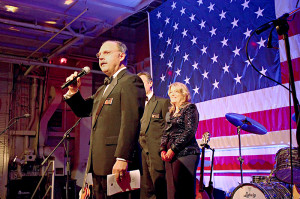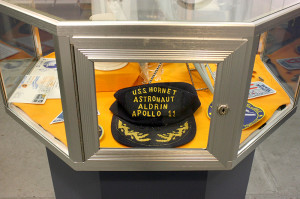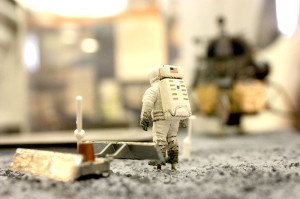Astronaut and Veterans Honor 70 Years of USS Hornet

their years of service.
In 1954, Dale Berven flew his Grumman F9F-6 Cougar jet high over the South China Sea on a search and rescue mission for survivors of a Cathay Pacific passenger flight.
The small passenger plane was shot down by Chinese fighter jets off the coast of Hainan Island. Some survivors were picked up by a USAF Albatross seaplane, while others were rescued by a British RAF Short Sunderland seaplane. 10 of the 19 passengers lost their lives.
On Saturday, the veteran fighter pilot and his former shipmates returned to the USS Hornet, now moored at the old naval base in Alameda, to commemorate the ship’s 70th anniversary.
The 15th anniversary of the Hornet’s conversion to a museum ship was also celebrated with the unveiling of a new exhibition “Hornet: Reflections through Time.”
Visitors were welcomed aboard the former U.S. aircraft carrier to listen as veterans shared their stories of the ship’s decorated past at a special panel discussion.

of his pride in serving in the space program.
Among those who spoke were several WWII pilots who flew combat missions in the Pacific Theatre, a senior crewmember with five tours in Vietnam, and astronaut Richard Gordon, who took part in the Apollo 12 mission, and was scheduled to walk on the moon in Apollo 18 before it was canceled due to budget cuts.
Berven, who flew 90 combat missions as a fighter pilot in Korea before joining the Hornet in 1954, said he was initially hesitant to return to his former ship.
“I did not want to come back. And then my wife talked me into coming over,” said Berven. “I met two guys the very first day and they encouraged me to become a docent [of the museum], which I have, and I love it.”
He now gives guided tours of the Hornet and shares his experiences with younger generations.
“This is my home away from home, I’m here a minimum of three days a week. And my whole purpose is the love of this ship, the love of naval aviation, and to try to educate our citizens about 20th century history, which many of them don’t know.”
The day’s events were followed by an anniversary gala to raise awareness and funds for the preservation of the ship and the museum.
Among the honored guests was Captain Gordon, who flew as command module pilot of Apollo 12, the second manned mission to land on the moon.

re-entry from the Apollo 11 and 12 missions.
In 1969, Gordon remained aboard the Yankee Clipper as it orbited the moon. He was assigned the task of taking photos of potential landing sites for future missions, while his two crewmates walked the surface of the moon.
After their successful mission and splashdown near American Samoa, the Hornet was onsite to recover the three astronauts.
“It’s just like coming home, this is the first place I was after we got back from Apollo 12, we got on the helicopter and landed here on the Hornet,” said Gordon.
When asked about the importance of the history of the Hornet and the U.S. space program, Gordon replied, “You’re damn right it’s important, we live with our history and that’s what makes us great.”
“This is a historic vehicle, it goes back for many, many years, and it ended its career with Apollo 11 and Apollo 12,” said Gordon.
Randall Ramian, chief executive officer of the USS Hornet, echoed his sentiment, “The USS Hornet is a national treasure that has participated in some of the greatest events of the 20th century, including WWII and Vietnam. The Hornet also performed flawlessly as the prime recovery ship for both Apollo 11 and 12, America’s [first] manned space missions to the moon.”
Throughout its history, the Hornet had an uncanny knack for showing up in the right place at the right time.
After it was commissioned in 1943, the carrier played a pivotal part in US action in the Asia-Pacific during World War II. Her planes bombed Japanese positions on Guam, Iwo Jima and Okinawa; she supported the amphibious assault on the Marianas Islands, fought in the Battle of the Philippine Sea, and helped sink the crown jewel of the Japanese fleet, the mighty battleship Yamato.
The Hornet destroyed 1,420 enemy aircraft and sunk 54 enemy ships over the course of World War II. But the ship’s service record does not end there; the Hornet went on to complete three cruises of Vietnam during the war, and recovered the astronauts from Apollo 11 and 12.
The annual cost to maintain, staff, and operate the aircraft carrier and museum is $2.8 million and increasing every year, said Ramian. The Aircraft Carrier Hornet Foundation, which saved the ship from the scrapyard and now runs the ship and museum, receives no government funding.
Ramian said the goal of the fundraiser was to raise awareness of the historic landmark, and to raise financial support for the continued maintenance and expansion of the museum’s collections and education programs.
To help raise these funds, a charity auction was held during the gala. Among the items for auction was an autographed Willie Nelson guitar, an African Safari package, and a private dinner for six with a US astronaut who worked onboard the International Space Station.














